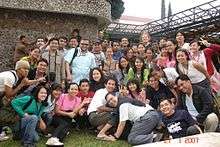Asia Source
Asia Source was an event series that promoted and coordinated the use of Free and Open Source Software (FOSS) in Asia. It took place three times: the first event was hosted in Bangalore, India in 2005, the second in Sukabumi in West Java, Indonesia in January 2007.[1] The third event was held in Silang, Cavite in the Philippines.[2]
Asia Source gathered FOSS experts and advocats from all over Asia, mostly IT professionals, trainers and FOSS practitioners from non-government organizations (NGOs), IT training institutes and small and medium enterprises (SMEs).[3]
Organisers
The series of Asia Source events was organised by UNDP APDIP via International Open Source Network (IOSN), Inwent, Tactical Technology Collective, Aspiration, Hivos, ICT watch, IDRC and the Centre for Internet and Society, India. IOSN is an initiative of the UNDP Asia-Pacific Development Information Programme.
The Asia Source event series is based on the source camp template of the Tactical Technology Collective, an international nongovernmental organization that trains rights advocates to deploy information and communications technologies.
Goals
The goal of the event was to motivate and facilitate the adoption of Open Source Software as tools, and also as a mind-set and attitude that promotes the use of open source software for communities to minimize the digital divide.[4] This event aimed to build skills and networks amongst the professionals working at local level across Asia by providing a range of hands-on and practical sessions in the usage of FOSS.[5]
Asia Source 2
Participants

The second event, Asia Source II, took place over nine days, with over than 130 participants from 27 countries, including Iran, Bangladesh, India, Pakistan, Nepal, Sri Lanka, Mongolia, Egypt, England, United States of America, Canada, Australia, Netherlands, Germany, Poland, Greece, Malaysia, Thailand, Cambodia, Laos, Vietnam, The Philippines, Timor Leste and Indonesia.
Participants were grouped into four tracks which are 1. Open publishing and broadcasting, 2. Alternative hardware and access, 3. Migrating to FOSS, and 4. Information management.
Camp structure
This event was a source camp style, in which the participants were gathered in a localized resort which include a main hall, track rooms and surrounded by bungalows. Each day started with a morning circle that assemble all participants in the main hall. Except for day one, the morning circle has report back sessions of the previous day training.
After the short morning circle the participants were separated according to their appointed track to follow the mandatory materials until noon.
After breaking for lunch, the afternoon continued with sessions contributed by the participants. Each participant was required to propose and schedule a short session describing his/her specialty or any related topic of interest. There were skill shares, lightning talks (speed geekings), or any other Birds of a Feather (computing) style sessions.
Each day ended up with a free evening of entertainment. There were cultural dances, movie night, karaoke night, game night and a special bazaar evening for the whole party.
Topics
Topics of the event included ease of use of FOSS, gender issue, and reach out with FOSS. More on social justice and civic rights issues[6] like human rights, ethnic minorities, women/children, disabled, anti-corruption, public health and environment were also mentioned. A session on FOSS Disaster Management System was also presented by a team from Sri Lanka for solution in time of disasters.
Asia Source 3
Asia Source 3 gathered 150 representatives in Silang, Cavite in the Philippines from November 7 to 12, 2009 to discuss regional developments in open source. * [7]
Asian countries represented in Asia Source 3 include Bangladesh, Burma, Cambodia, China, India, Indonesia, Kyrgyzstan, Laos, Mongolia, Pakistan, Philippines, Sri Lanka, Thailand, Timor Leste, Vietnam.[8]
References
- ↑ http://web.archive.org/web/20081120014634/http://www.it-foss.org/e133/e500/e708/index_eng.html
- ↑ http://www.tuxmachines.org/node/13174
- ↑ http://web.archive.org/web/20081120014634/http://www.it-foss.org/e133/e500/e708/index_eng.html
- ↑ "Archived copy". Archived from the original on 2010-01-11. Retrieved 2009-10-26.
- ↑ "Archived copy". Archived from the original on 2009-09-12. Retrieved 2009-10-20.
- ↑ "Archived copy". Archived from the original on 2016-03-04. Retrieved 2009-10-27.
- ↑ Manila Bulletin article: Asian ‘campers’ troop to Cavite, reinforce open-source movement: https://web.archive.org/web/20110607222343/http://www.mb.com.ph/articles/235859/asian-campers-troop-cavite-reinforce-opensource-movement
- ↑ http://web.archive.org/web/20120228194436/http://www.it-foss.org/e82/e237/NewsDetail750/index_eng.html
External links
- Asia Source II wiki
- Asia Source II on Tactical Tech
- Asia Source 2 - FOSS Stories from the South
- The International Open Source Network (IOSN)
- Asia Source II Free and Open Technology for NGOs and SMEs
- Asia Source II on Center for International Media Action (CIMA)
- Asia Source II on Center for International Media Action (CIMA)
- Asia Source 3 website
- Asia Source 3 call for participation